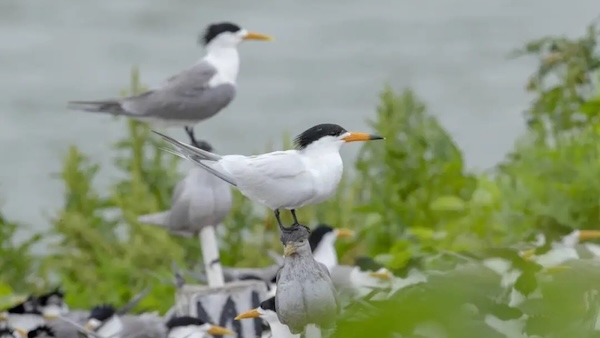Youth revitalize lion dance tradition

Children participate in the parade as lion dancers in Qiantong township in Ningbo, East China's Zhejiang province, Feb 20, 2022. [Photo/Chinanews.com]
In the streets of Qiantong township in Ningbo, East China's Zhejiang province, a parade with young lion dancers, hopping mischievously to the beats of drums and gongs, became the topic of discussion last week.
The lion dance team, composed mainly of primary and secondary school students from the township, debuted their first public performance on Sunday after going through intense training during their winter break.
The children's coach, Tong Panfeng, is a Qiantong native filled with passion and a heart to revitalize this dying traditional performance.
Dating back to the Qianlong reign of the Qing Dynasty (1644-1911) in the 18th century, the tradition of lion dance has been a part of the township for a long time.
However, it gradually faded away during the mid-20th century.
In 1993, Tong, then 26, was greatly inspired by Once Upon a Time in China III, a movie about the legendary martial artist Wong Fei-hung.
Tong was deeply mesmerized by the elements of lion dance depicted in the movie, and after learning that his grandfather had been a member of the former Qiantong lion dance team, Tong wanted to restore this amazing tradition.

Members of Qiantong central primary school's dragon and lion dance team stand together for a photo shoot. [Photo/Chinanews.com]
In 2015, Tong traveled to various places to learn the art of lion dance, visiting performers in other regions such as Shandong and Anhui provinces and the Guangxi Zhuang autonomous region.
He began promoting the dance after returning, only to realize the limitation of working alone on the path of cultural revitalization.
Tong came to the conclusion that he needed to start from the very foundation of tradition and culture – people, and to teach children the art of lion dance.
In 2017, Tong recruited young students with the support of local authorities and the Qiantong central primary school.
He established the "dragon and lion dance team of Qiantong central primary school" and taught lion dance as an extracurricular course.
Under Tong's guidance, groups of young boys and girls could often be seen practicing for eight hours during the weekends.
Their hard work has often been spotted on the school's playground, in the yard of the town's ancestral hall, and on the hills in the surrounding mountains.
"Practicing lion dance is not only inheriting the tradition, culture, and skills of our hometown, but also strengthening our body. We all love this sport very much," said a young lion dancer of the team.
Far from just a performance, Tong firmly believes that lion dance symbolizes the high spirit of the Chinese nation and the pride of the Chinese people.
"Where there are Chinese, there are lion dancers," said Tong.
In recent years, the children have won multiple national and provincial championships.

 Ningbo seabird project seeks international volunteers
Ningbo seabird project seeks international volunteers  Jakub's journey: From shipyard to sea
Jakub's journey: From shipyard to sea  Badminton Asia COO applauds Ningbo
Badminton Asia COO applauds Ningbo 


